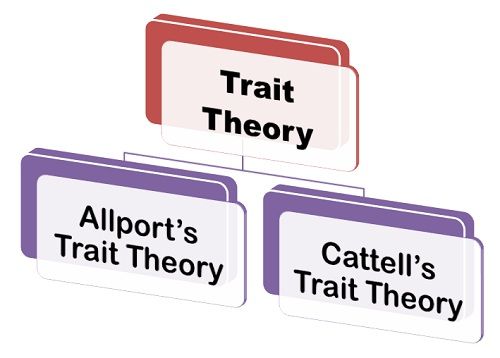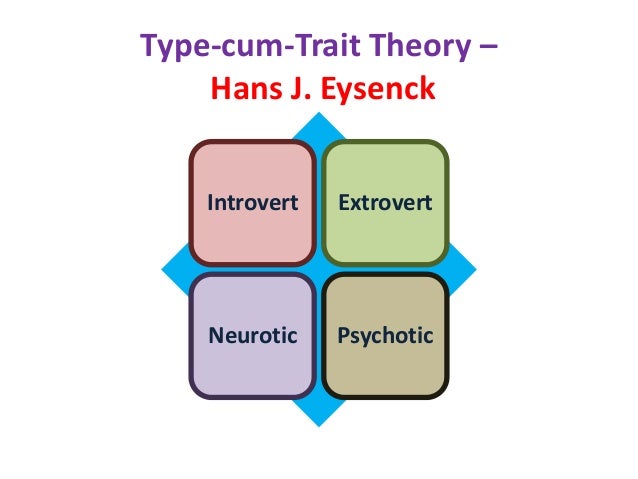Trait approach assumes behaviour is determined
by relatively stable traits which are fundamental units of one’s personality.
These are defined as relatively stable and consistent personal characteristics.
A)
G.B Allport
B)
Raymond B. Cattell
C)
Hans Eysenck
D) Guilford

Allport’s Trait approach to Personality:
G.B
Allport was the first personality theorists who adopted Traits are the basic
units of our personality. He tried to search basic units of human behaviour.
Out of 17,953 words listed for the description
of the personality of the human beings, he arrived at 4,541 words classifying
these traits inro 3 main types named as
a)
Cardinal traits
b)
Central traits &
c) Secondary traits under individual traits.
Allport recognized the following into 2 major
categories:
a)
Common
Traits: These traits include
those we share in common with many others in culture.
e.g.:- being quiet, showing respect to seniors, making polite behaviour to others, etc.
ii) Individual Traits: These traits are also known as personal dispositions which are unique to the person concerned.
a)
Cardinal
traits: The word ‘cardinal’
means important, primary, central and fundamental. This is the one that
dominates and shapes a person’s behaviour.
e.g.:- someone who is obsessed with becoming wealth, another person whose life focus is religion, etc.
b)
Central
traits: This is a general
characteristic found to some degree in every person.
e.g.:- honesty, kindness, submissiveness, smartness, shy, etc.
c)
Secondary traits: This is
a characteristic seen only in certain situations. Preferences, attitudes and
situational are all secondary.
e.g.:- uncomfortable in large crowds, likes to drive sports cars, etc.

B) Cattell’s Trait Approach
Cattell
defined traits as relatively permanent reaction tendencies that are basic
structural units of the personality.
He classified traits into several ways:
1)
A common trait is one that
is possessed by everyone to some degree. E.g.: Intelligence, Extraversion,
Gregariousness, etc
2)
Unique
traits are particularly apparent
in our interests and attitudes. E.g.: interest in playing cricket, watching Chinese
martial arts, etc.
3)
Ability
traits determine how
efficiently we will be able to work towards a goal. E.g.: Intelligence.
4)
Temperament
traits describe the general
style and emotional tone of our behaviour. E.g.: easygoing, how assertive,
irritable we are, etc.
5)
Dynamic
traits are driving forces of
behaviour. They define our motivations, interests and ambitions.
6)
Surface
traits are personality
characteristics that correlate with one another but do not constitute a factor
because they are not determined by a single source. E.g.:- several behavioral
elements such as anxiety, indecision and irrational fear combine to form the
surface trait labelled neuroticism.
7)
Source
traits are those individual
factors derived from factor analysis that combine to account for surface
traits.
8)
Constitutional traits originate in biological conditions but are
not necessarily innate. E.g.:- alcohol or drug use can lead to behaviors such
as carelessness, talkativeness and slurred speech.
9) Environment-mold traits derive from influences in our social and physical environments that impose a pattern on the personality.
C) Eysenck’s Trait Hierarchy
According to Hans Eysenck, personality is determined by genes and that the environment factors have very little role to play in it.
In view of hierarchical taxonomy as given by Eysenck, Personality is hierarchically organized consisting of Types, Traits and Habits.
Eysenck described the dynamics of personality as involving the relationship of basic 3 types of traits – Extraversion, Introversion, Neuroticism and Psychoticism. These dimensions are assesses using the Eysenck Personality Questionnaire. Inhibition and Arousal theory are also developed by Eysenck.

Eysenck traced the differences in behavior
between introverts and extraverts to various parts of the Ascending Reticular
Activating System (ARAS).
The ARAS is a network of fibers traveling upward from the lower brain stem to the thalamus and cortex. Stimulation of the ARAS results in increase in alertness and Arousal of the cortex.
D) Guilford’s Trait Theory
Guilford (1959) like Allport stresses the integration of traits when he discusses the individual’s pattern of traits. He groups traits into 7 modalities or classes which are Interest, Attitude, Needs, Temperaments, Aptitude, Physiology (basic bodily functions) and morphology (body structure).

No comments:
Post a Comment